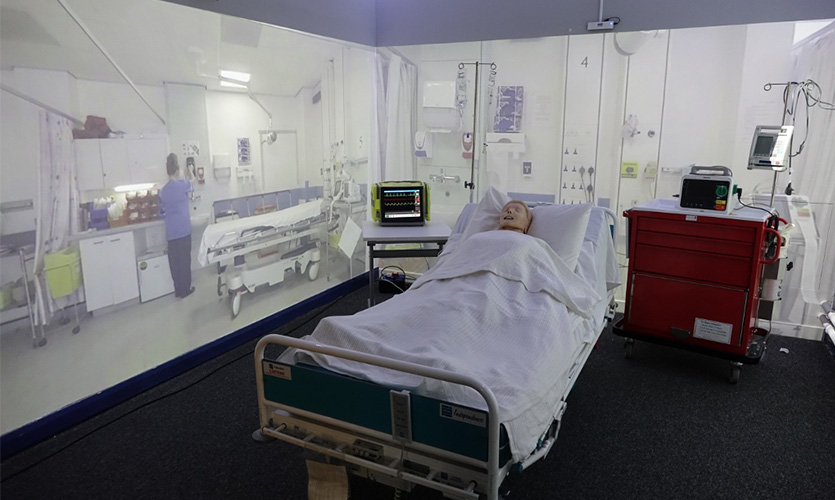Sharing Practice – The Faculty of Health Immersive Room

For this week’s topic we would like to highlight the Faculty Immersive Room and share some of the practice happening within it.
Based in Tithebarn 3.20 it contains three projectors and specialist immersive software. This allows you to project images or video stitched together on to three separate walls, which combined with sound, allow for the recreation of a wide variety of real world and imaginary scenes that are ideal for role-play and scenario work.
Faculty colleagues Jenny Vasey and James Woollacott have kindly offered to share how they have been using the Faculty Immersive Room below:
The setup
“We recently utilised the immersive suite to teach the ‘pit-stop’ CPR concept to our paramedic students. We ran the session 4 times, each with 6 students across the course of one day. We started the session by having a discussion regarding the students’ current knowledge and experience of out of hospital CPR and the delegation of roles, with an introduction to the ‘pit-crew’ model, showing a video of best practice. We then allocated roles to the students that they would play in a simulated scenario.”The task
“Attend the immersive suite which is now transformed into a simulated nightclub, complete with music. There is a ‘50-year-old patient reported to be in cardiac arrest with bystander CPR in progress.”
The results
“As tutors and believers in experiential learning we know the immersive suite is an invaluable resource here at LJMU. Being able to watch the students in a simulated environment meant we were able to gain a real insight into how they will perform as paramedics of the future. More importantly, the students were able to push themselves and test their knowledge uninterrupted and in real time. They developed their voices as leaders and as future paramedics. They successfully worked as a team, they managed the scene and bystanders, provided an initial assessment, prioritised clinical interventions including; airway management, IV access, minimal interruptions to chest compressions and defibrillation when required. They discussed all reversible causes of cardiac arrest and worked together to achieve safe extrication of the patient to ‘resus’. The student feedback was fantastic, both on the day and for some time after.”
My thanks go out to Jenny and James for generously sharing their experiences with the Immersive Room with us. You can see more general examples of how you can use an Immersive Room on the Immersive Interactive website.
If you would like more information on the Faculty Immersive Room or are looking for more ways to use technology to enhance the student experience or course, curriculum and assessment design or if you are thinking of using Panopto, Office 365, Visible Bodies, clinicalskills.net or a none institutional technology for the first time please contact the team.
Created by Jenny Vasey, James Woollacott and Chris Gillies
